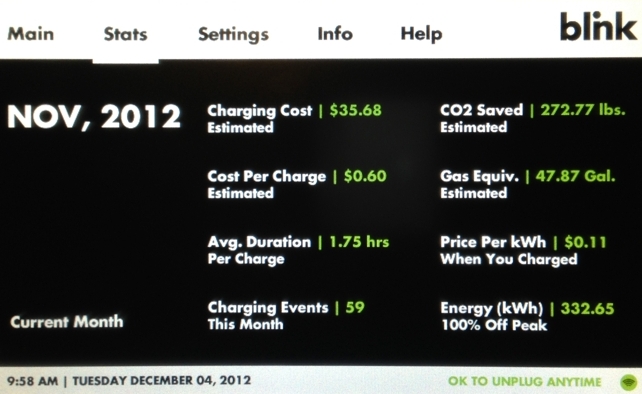We’ve just completed our first month of using the Blink Level 2 chargers, so we will begin to see if the investment was worth it or not.
Here are the givens, based on my actual mileage (from my spreadsheet) from October 8th until today:
- My miles per kilowatt hour have been averaging 4.21
- My miles per gallon have been averaging 37.6
- Currently, premium gasoline is $3.30 per gallon
- My electricity cost is locked in for a year at $0.10725 per kilowatt hour.
The above mileage figures were during drives where the temperature has ranged between 40 degrees and 87 degrees Fahrenheit. Summer morning drives will be within this range, but afternoons will be hotter. Winter mornings will be colder but most afternoons will probably be within this range. Therefore, actual results may be slightly worse than the predictions below.
At the end of October (before Blinks were installed), my Volt had the following mileage stats:
- 3532 Electric Miles
- 4641 Total Miles
- For all the miles driven so far, 76% of the miles were powered by electricity, instead of gas.
At the end of November, my Volt had the following mileage stats:
- 4638 Electric Miles
- 5906 Total Miles
- That’s 87% electric driving, just for the month of November!
- For all the miles driven so far, 79% of the miles were powered by electricity, instead of gas.
So, where does that put us? If the average percentage of miles driven on electricity remains at 87%, we drive 15,000 miles per year, and gas stays around $3.30 for premium, then this is our cost, per car, with and without the Level 2 chargers:
With Blinks:
- 15,000 total miles
- 13,050 miles on electricity (87%): cost $332.45
- 1,950 miles on gasoline (13%): cost $171.14
- Total fuel (gas + electricity) cost: $503.59
Without Blinks:
- 15,000 total miles
- 11,400 miles on electricity (76%): cost $290.42
- 3,600 miles on gasoline (24%): cost $315.96
- Total fuel (gas + electricity) cost: $606.38
You may recall that my previous car would have cost $2,045 (at current gas prices) to fuel for a year. I LOVE MY VOLT!!!!!
Conclusion
It looks like we will save $102.78 per year, per charger. That’s a bit disappointing. As you may remember from an earlier post, we did not pay for the chargers, due to a government-funded program. We did however, pay for installation of the chargers, which averaged $342.50 per charger. I also ran the two 240 volt circuits, with the help of a neighbor,at a cost of $171.25 per circuit, for a total coast of $513.75 per charger. At the above savings rate, it will take 5 years, to recoup the cost of the installation. If we had paid for the chargers as well, our cost per charger would have gone up between $749 to $1,099. and take between 12.3 and 15.7 years to recoup the cost.
At this point, I’d have to say that Level 2 chargers are not worth the investment for most Volt drivers, unless they really want to maximize the electric miles for purely ecological / geopolitical reasons. Fortunately, Bonnie & I fall into that category.
For those driving purely electric vehicles, Level 2 chargers are a must, in my opinion, unless they have another, non-electric form of transportation, in case of emergency.

